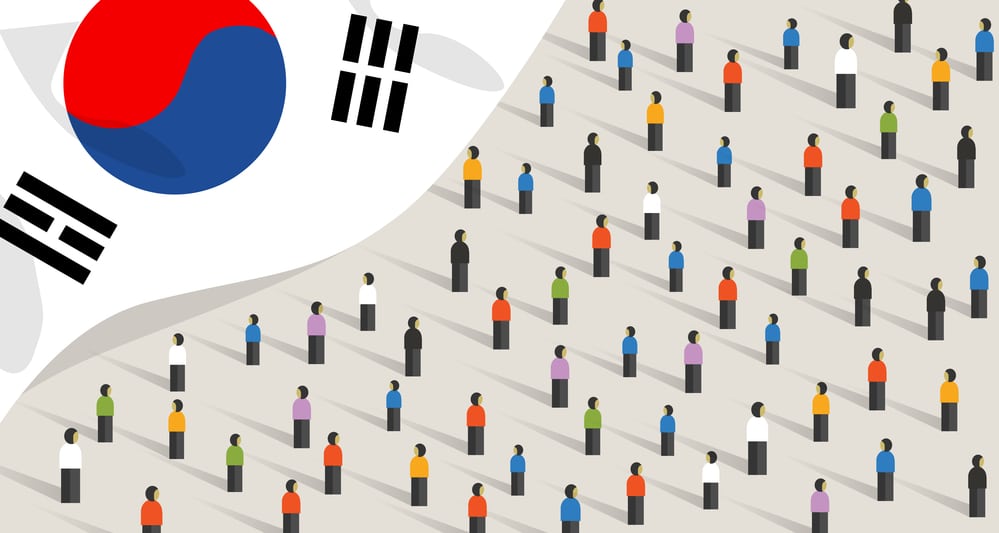Birthrates have been falling throughout the developed world for years. While it’s true that the global population can’t and shouldn’t grow forever, and that a gradual decline could be desirable, the current OECD (Organization for Economic Co-operation and Development) average birth rate of 1.6 presents serious, but manageable, challenges to maintaining economies and societies.
In South Korea the situation is much more dire, and this number has dropped to an abysmal lifetime fertility rate of .72 children per woman, or just over a third of the replacement rate. Without drastic action, this will lead to state collapse. Further, though South Korea has dumped around $250 billion dollars into this problem in the past twenty years the rate has only continued to fall. Alternately, while it is hard to get reliable statistics or information about government policies, and its birth rate may be slightly below replacement, it’s clear that communist, totalitarian North Korea does not currently suffer from this problem. This raises a question which should strike fear into every man who loves liberty: in the long run, does communist totalitarianism work better than free markets and civil liberties?
Like many problems we face, incompetent governments went to great efforts to create the fertility crisis. A recent short article from Financial Times contains stunning statistics about how South Korea’s crisis started and where the situation currently stands. In the 1970s, very serious people™ decided that global overpopulation would lead to a catastrophe and that birth rates must be controlled throughout the world. Amidst this mania, South Korea took up the slogan “One child per family is still too many for Korea,” but by 2005 when their birth rate hit 1.2 (still more than one child per family) the government realized that the fulfillment of such an insane goal would collapse their society. Since then, the government has put enormous amounts of money towards helping parents with housing, childcare, and schooling, but in South Korea’s affluence the people simply do not want to have children, something which is ironically attributed to poverty.
Curiously, the Financial Times article says that South Korea has such a competitive culture that no matter how much the government funds schools people still insist on sending their kids—if they have them—to expensive private schools. This may accurately reflect public sentiment but it is idiotic. South Korea currently produces half the babies necessary to maintain its economy, meaning that in sixteen years Hyundai will probably be trying to pay your kid to drop out of high school and take high-paying factory job. If things stay how they are the bigger risk than your kid not “competing” is a nation of managers trained at elite schools with no one to manage. Further, rents will have plumetted as people die and there is no one to move into their apartments, meaning a key aspect of cost of living will go down as wages rise. Poverty cannot be the reason for low birth rates in South Korea; people do not want to have children and are making excuses.
The situation is different in North Korea. The country is famously secretive and also maligned, so all information about it must be taken skeptically. Frankly, while it probably really is a commie hellhole, with the way our ruling class lies it wouldn’t be that surprising if North Korea was a hidden paradise. Regardless, the CIA Factbook claims that in 2024 North Korea had 1.8 lifetime births per woman—below replacement rate but only a modest decline. Though articles periodically come out claiming things like “Kim Jung-Un Has a Population Problem,” arguing that North Korea may follow its southern counterpart is entirely speculative.
A widely-cited article in the U.S. propaganda outlet Radio Free Asia claimed in 2015 that the North Korean government had banned birth control and abortion to curb population decline. The anonymous “sources” on which the article relied claimed that this would be ineffective as people would seek illegal birth control and abortions, though no evidence is presented of any claims made in the article. Further, a source states, “Most married couples deliberately have only one child because of the high costs of education and child rearing.” This contradicts the U.S. government’s fertility statistics for North Korea showing women average close to two children and by extension the majority of couples with children have more than one child. As it stands, in isolation, oppressed, impoverished, and with a dreadfully inefficient economic system and few trade partners, the North Koreans are still willing to have children. Perhaps this is because they want the joy in their lives and have not been lulled into complacency, or it is out of patriotic sentiment engendered by their national project, or for any number of other reasons; but regardless, they have children.
South Korea’s population collapse could lead to it losing over half its population by 2100. At the current rate, each generation will be just over a third the size of the population which birthed it. There are about as many people currently alive in South Korea who were born in 1942 as those who were born in 2022. These are roughly the population losses of the Black Plague in medieval Europe, caused by nothing more than the public choosing that it is not worth it to continue their people or their nation. Some blame the toxins of the modern world for making people less fertile in the biological sense, but many fertility treatments are available and it is clear this is primarily an issue of not wanting children.
Alternately, perhaps North Korea’s totalitarian government allowed it to rapidly respond and they did ban contraception and abortion which were successful policies for raising birth rates. As it stands, though it has been imagined that North Korea’s weak economy would ultimately leave it desperate for reunification, it is more likely that South Korea ends up needing North Korea because it has workers, even if this requires some sort of Hong Kong-esque “two systems, one country” scheme which allows Kim to retain full political control of the north. That assumes reunification is peaceful; every year South Korea becomes less able to fight a war due to sheer lack of young men.
While South Korea is not a perfect picture of freedom, the two Koreas are still the best representation of otherwise comparable countries following the divergent paths of economic freedom, civil liberties, and international trade compared to “self-sufficient” communism and a total state. North Korea is known as dystopian, but if the trend continues for ten more years South Korea will be going extinct at such a rapid rate that it will be like the subject of many dystopian novels. It is often said that Nineteen Eighty-Four showed a totalitarian state where man was controlled through misery and Brave New World was one where man is controlled through pleasure; while North Korea has long been the former, South Korea has become the latter and may have to adopt similar breeding policies to survive.
While South Korea is the farthest along, much of the developed “free world” is trending this direction. How well do freedom and free markets work if no one wants to have children in such countries once they economic maturity? Currently, many countries are importing huge numbers of new people from poor countries, who themselves will likely adopt the same habits of low reproduction in just one or two generations, and this ignores the question of at what point you’ve simply let your country be taken over by others instead of saving it. South Korea’s experience shows that this problem is unlikely to be solved with government benefits, tax incentives, and similar policies. Poverty has never stopped the poor from having kids. That is only a claim made by the relatively affluent. It seems clear that if we cannot convince free people to choose to have more children, governments will turn to oppressive means that fifty years ago one would only find in dystopian novels. South Korea is already running out of other options.































